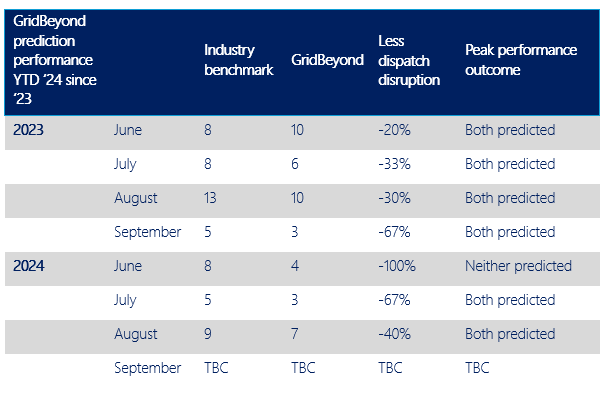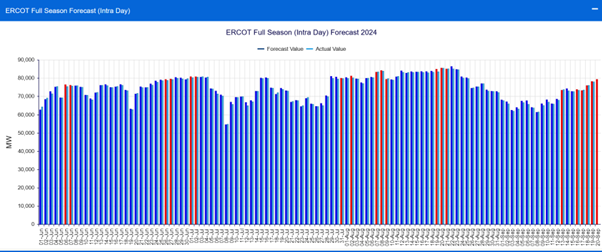News
better business decisions
Posted 1 year ago | 6 minute read

Why does ERCOT count on 4CP?
As the entity in charge of reliability for the Texas grid, ERCOT monitors the stress the grid is expected to endure during the extreme 4 hottest summer months. (JUN-SEP). They will charge any user, through the Transmission and Distribution tariff (T&D Charge line on your bill) for whether you are using power during those peak grid intervals. The premise is to deliver reliable electricity regardless of how many users are drawing on it.
If you are drawing or using power on the grid during these 15 minute interval peaks, you get charged full “toll”. If you are off and shedding or pausing your use of power for these peaks, ERCOT credits your bill that T&D charge which can be worth up to a third of your total bill. Your power bills consist of two primary components: energy charges which are based on the total energy consumption during the billing period, measured in megawatt-hours (MWh); and demand charges that are charged based on the maximum short-term power draw during a specified period, measured in megawatts (MWs). 4CP helps ERCOT know how fast and what amount of loads the demand users can do in a short periods of time so they can plan longer term for overall system capacity and better prepare for a potential constraint phases in the future.
In this article we examine 4CP charges, a particular type of demand charge in the ERCOT market and how to best monetize flexibility for maximum gain/cost reduction.
Understanding demand charges
Traditional demand charges consider a customer’s peak short-term demand within a larger time frame, such as a 15-, 30-, or 60-minute interval within a monthly billing cycle. Costs are then assigned to those MW’s of demand, which appear on each power bill.
Demand charges are intended to “recover most or all shared system capacity costs.” This is because peak capacity drives transmission system improvements and expansions, necessitating the recovery of these capital expenses.
ERCOT’s 4CP program
In the ERCOT market, demand charges are managed through the Four Coincident Peak (4CP) program. Demand in Texas typically peaks during summer months due to extreme hot weather and increased air conditioning use, which strains the electricity grid represented by tighter supply and demand spreads.
Under the 4CP program, ERCOT identifies the peak overall electricity demand on the grid during these four 15-minute intervals, one each in June, July, August, and September. Costs are then allocated to the state’s various transmission & distribution service providers (TDSPs) based on their share of the total ERCOT peak load. TDSPs recover their cost obligations through wires/infrastructure charges on all loads.
The energy usage measured at those peak times determines your TDSP charges for the following year. If the peak measurements are exceptionally high, your rates may be locked in at above-average costs for the following year.
Essentially, one hour (four 15 minute interval periods) of electricity demand out of the 8,760 hours in a year can account for 30% or more of industrial power costs savings or approximately 1/3rd of your utility bill.
What is a more effective 4CP management outcome?
The key is to know the right days and the right times to make the cut or pause your use of power, relieving the demand side of the grid dynamic.
The challenge for you is to find a service provider who has prediction models you can trust to predict and dispatch and avoid unnecessary or over dispatched calls that interrupt your business too frequently. If you can’t trust the accuracy of your service provider’s dispatch approach or fatigue due to over dispatch starts to question the objective, you might:
- write off 4CP charges as a cost of doing business and ignore the revenue opportunity
- guess when the peaks will occur and reduce demand pre-emptively
- use analytics for better insights and reduce demand only as appropriate
- create rules that shut down equipment whenever prices go above a certain threshold and hope they coincide with the actual ERCOT peak intervals.
As the ERCOT grid continues to break its own peak demand records, it is getting harder and harder to accurately predict 4CP moments. As a result many 4CP dispatch service providers are calling increased numbers of dispatch events that can vary from a couple of dispatches to 12 or more in a single month.
Why is GridBeyond’s 4/5CP prediction model different?
At GridBeyond we do things differently. Using modern AI and machine learning applied to the characteristics of the grid and “machine train” to recognize the behaviors of weather, congestion, demand patterns, supply expectations etc, (over 20 different data points) to best capture this tariff relief.
Our AI program provides a day-ahead notice that a 4CP is expected, a morning of notice that reconfirms and then a final accuracy check later in the afternoon. If it appears the peak predicted the day before will fall short of prior peaks or is expected to be lower than future peak predictions, we’ll call it off allowing you to avoid an unnecessary curtailment and operations interruption.
How accurate is GridBeyond to date in these predictions?
GridBeyond is always benchmarking against other services and how we do against the competition, so we benchmark for key reasons:
- Did we predict the peaks.
- Did we do it with fewer dispatches and greater accuracy?
- Did we do it in fewer hours per dispatch?
- Did this result in fewer disruptions for our clients?
- Were we successful in catching the prediction and thus the savings to our client base?

In 2023 ERCOT set 10 new all-time peak demand records with one last September 8th, hitting 84,182MW, breaking the previous September record set just the day prior at 83,911MW. In 2023 our platform successfully called all 4CP periods while only issuing 9 fewer warning, (approximately 18-27 fewer hours) in total than the competitive benchmarks. We have maintained this forecast accuracy in 2024 and having dispatched 8 fewer warnings to date (16-24 fewer hours) – than the competitive benchmark accomplishing two things for our customers – avoided unnecessary disruptions increasing productivity while capturing the full value of the approximate 30% tariff relief from more accurate predictions and dispatch.
Speak to one of our experts to find out how we can support your business with 4CP management in 2025 and book a meeting with GridBeyond today

Our demand charge management tools are also available in the PJM market, where in 2022 and 2023 GridBeyond’s modelling successfully predicted all five Coincident Peak (5CP) periods while only issuing seven warnings in total at only 2 hours per dispatch, greatly outperforming the competitive benchmark in that market.

Your 4CP management strategy
Over the last five years, transmission charges in ERCOT have increased more than 50%, with further rises on the horizon. But, a 4CP management strategy may be the trick to maximizing your use of renewable energy and reducing your costs during the hottest time of the year.
Learn more







